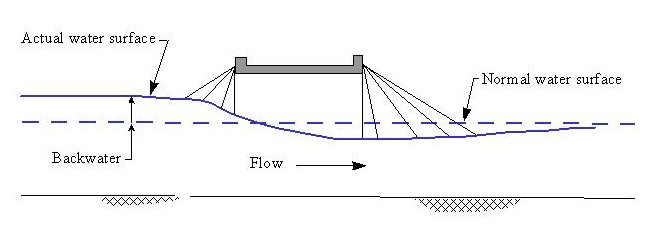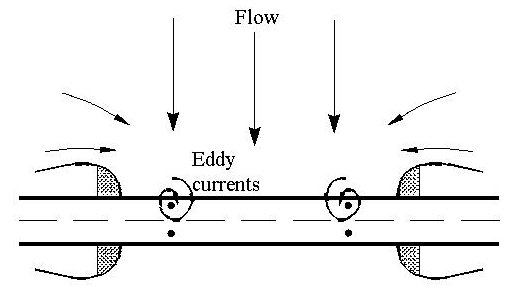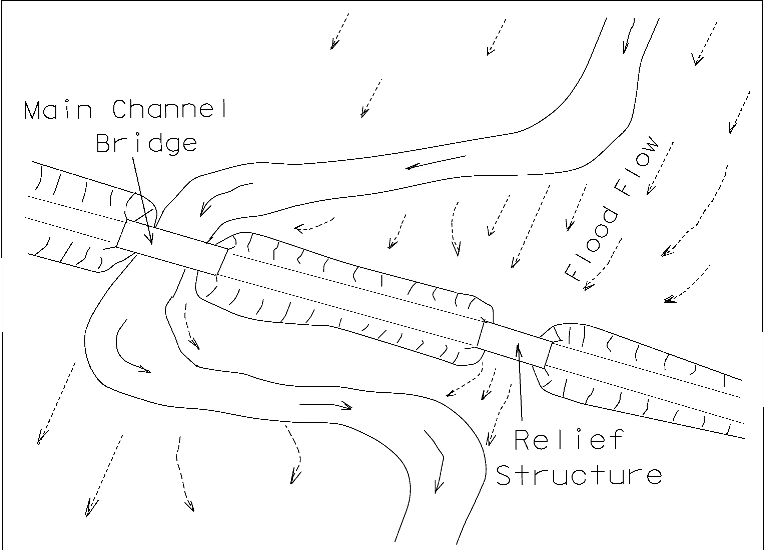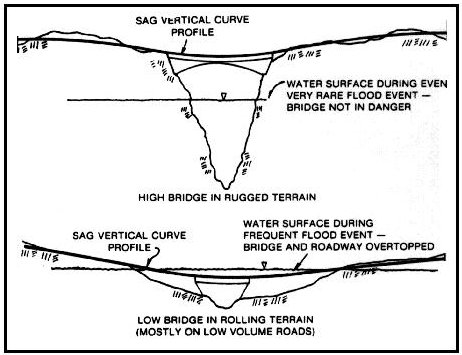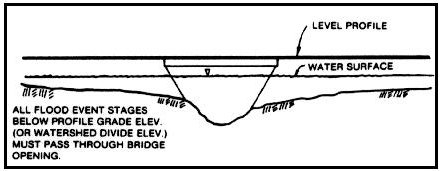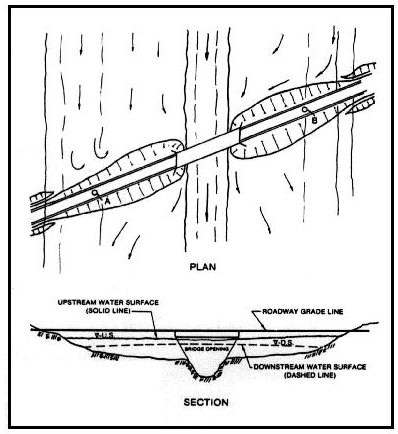Section 3: Bridge Hydraulic Considerations
Anchor: #i1006995Bridge/Culvert Determination
The first step in analysis for a cross-drainage facilityis the establishment of the flood frequency curve and the stage-discharge curve according to Chapter 4, Hydrology Study Requirements, and Chapter 6, Open Channel Flow; and the second step is to make a decision concerning the type of cross-drainage structure. All types of facilities should be appraised based on performance and economics. The choice is usually between a bridge and culvert. If the stream crossing is wide with multiple concentrations of flow, a multiple opening facility may be in order.
At many locations, either a bridge or a culvert will fulfill both the structural and hydraulic requirements for the stream crossing. The roadway designer should choose the appropriate structure based on the following criteria:
- Anchor: #UPXTBXKQ
- construction and maintenance costs Anchor: #TYCSFEEM
- risk of failure Anchor: #RBWPUDOA
- risk of property damage Anchor: #ESOXGTHI
- traffic safety Anchor: #JMGHRSJY
- environmental and aesthetic considerations Anchor: #GYFGRWWQ
- construction expedience.
Although the cost of an individual bridge is usually relatively small, the total cost of bridge construction constitutes a substantial share of the total cost of highway construction. Similarly, bridge maintenance may account for a large share of the total cost of maintaining highway hydraulic features. The roadway designer can achieve improved traffic service and reduced cost by judicious choice of design criteria and careful attention to the hydraulic design of each bridge.
Anchor: #i1007017Highway-Stream Crossing Analysis
The hydraulic analysis of a highway-stream crossing for a particular flood frequency involves the following:
- Anchor: #VUXQDYSF
- determination of the backwater associated with each alternative profile and waterway opening(s) Anchor: #YFKCLIRI
- determination of the effects on flow distribution and velocities Anchor: #LAHUCONR
- estimation of scour potential.
The hydraulic design of a bridge over a waterway involves the following such that the risks associated with backwater and increased velocities are not excessive:
- Anchor: #HIMDILWU
- establishing a location Anchor: #VPSAKAFA
- bridge length Anchor: #KGCOWDXJ
- orientation Anchor: #DOIWLXNM
- roadway and bridge profiles.
A hydrologic and hydraulic analysis is required for designing all new bridges over waterways, bridge widening, bridge replacement, and roadway profile modifications that may adversely affect the floodplain even if no structural modifications are necessary. Typically, this should include the following:
- Anchor: #NAWDNBVD
- an estimate of peak discharge (sometimes complete runoff hydrographs) Anchor: #FBQJAYLD
- existing and proposed condition water surface profiles for design and check flood conditions Anchor: #MUYPNDKF
- consideration of the potential for stream stability problems and scour potential.
See the Documentation Reference Tables in Chapter 3 for a complete list of requirements.
Anchor: #i1007087Flow through Bridges
When flood flows encounter a restriction in the natural stream, adjustments take place in the vicinity of the restriction. The portion of flow not directly approaching the bridge opening is redirected towards the opening by the embankment. The flow contracts as it enters the bridge and then expands as it exits the bridge. Maintaining the contraction and expansion of flow and overcoming friction and disturbances associated with piers and abutments requires an exchange of energy. An increase in the depth of flow upstream of the encroachment, termed backwater, reflects this energy exchange, as shown in Figure 9-1.
Figure 9-1. Backwater at a Stream Crossing
Anchor: #i1007108Backwater in Subcritical Flow
In subcritical flow conditions, the backwater tails off upstream until it reaches the normal water surface. The distance upstream over which backwater occurs depends on the channel conditions and flow conditions (see the Standard Step Procedure in Chapter 7). The maximum backwater tends to occur in an arc around the opening as Figure 9-2 shows. The relatively steep water surface gradient between the maximum backwater and the opening is termed the drawdown area.
Figure 9-2. Extent of Backwater Drawdown
In a stream channel with supercritical flow conditions a constriction such as a bridge may not affect the upstream flow conditions. However, if the constriction is severe enough, it could cause a change in flow regime such that a backwater occurs upstream of the bridge and a hydraulic jump occurs near the bridge.
As the flow becomes constricted as it moves toward the bridge opening, the velocity increases, which can result in scour along the embankment and through the bridge. At the bridge headers, intersecting velocity vectors can cause severe turbulence and eddies as shown in Figure 9-3. Piers in the waterway create additional local turbulence and vortices. Turbulence, eddying, and vortices often result in scour.
Figure 9-3. Typical Eddy Currents through Bridge Opening
Anchor: #i1007156Allowable Backwater Due to Bridges
For design frequency conditions, the allowable backwater should be established based on the risk of incurring flood-related damage to the highway and adjacent property. See Chapter 3 for discussion on Evaluation of Risk assessment. The allowable backwater should also consider the presence of FEMA mapped floodplains. See Chapter 5, for a more thorough explanation on the FEMA NFIP requirements.
Anchor: #i1007203Flow Distribution
Any stream crossing that uses a combination of fill and bridge within the floodplain disturbs flow distribution during some floods. However, the normal flow distribution should be preserved to the extent practicable in order to:
- Anchor: #NABKXCRO
- avoid disruption of the stream-side environment Anchor: #CEOPYUIS
- preserve local drainage patterns Anchor: #NEDWHJEV
- minimize damage to property by either excessive backwater or high local velocities Anchor: #KEEXIDNE
- avoid concentrating flow areas that were not subjected to concentrated flow prior to construction of the highway facility Anchor: #QEMVXYXY
- avoid diversions for long distances along the roadway embankment.
Generally, the disturbance of flow distribution can be minimized by locating bridge openings at the areas of high conveyance.
For many situations, one-dimensional analysis techniques suffice for determining optimum bridge locations. When analyzing complex sites, such as those at a bend (Figure 9-4), and at skewed crossings (Figure 9-9), a great deal of intuition, experience, and engineering judgment are needed to supplement the one-dimensional analysis. Unfortunately, complex sites are frequently encountered in stream crossing design. The development of two-dimensional techniques of analysis greatly enhances the capabilities of hydraulics designers to deal with these complex sites. However, two-dimensional models required a great deal more data, intuition, experience and time than a one-dimensional model.
Figure 9-4. Highway Stream Crossing at a Bend
Anchor: #i1007255Velocity
While some bridge openings may have a relatively uniform velocity across the entire bridge opening, in most instances there are wide variations in the velocity profile. In some segments of the flow (e.g., near the center of the stream), the velocity may be considerably higher than the average velocity. In areas of shallow flow, the velocity may be quite low. The velocity profile may even include negative velocities (reverse flows). Figure 9-5 shows an example of a velocity profile through a bridge opening.
The through-bridge velocity is the basic sizing criterion used for span-type bridges. The average through-bridge velocity is described by the Continuity Equation (see Equation 9-1).
Equation 9-1.
where:
- Anchor: #OMKUSRFO
- V = average velocity (fps or m/s) Anchor: #DMWBXOYN
- A = Normal cross-sectional area of the water (sq.ft. or m2)
Figure 9-5. Velocity Profile Through Bridge Opening (heavier lines = higher velocity)
In general, waterway velocities should replicate the velocity of the natural channel. Higher velocities may be acceptable in certain cases where the streambed is rocky or the bridge headers are sufficiently removed from the erosive effects of floodwaters.
Anchor: #i1007328Bridge Scour and Stream Degradation
A scour analysis is required for new bridges, replacements, and widenings. Where a scour analysis indicates high depths of potential contraction scour, a structure larger than that required by the basic velocity and backwater criteria may be more cost effective than to designing foundations and armoring to withstand the scour. The potential for deep local scour can be reduced by enlarging the structure, but designing foundations and armoring to withstand local scour depths may be more cost-effective. Generally, a multi-disciplined team should assess the validity of calculated scour depths.
Stream stability issues such as potential vertical and horizontal degradation may warrant accommodations in the bridge design. If the channel is vertically degrading, it is likely that, as the channel deepens, the banks will slough resulting in a widening. Also, where significant meandering is occurring, meanders tend to migrate downstream and increase in amplitude. Structural options to accommodate either of these cases can include longer structures with deep enough foundations to accommodate anticipated degradation or deep enough foundations with abutment foundations designed to act as interior bents to allow future lengthening of the bridge.
Refer to the Geotechnical Manual and the Bridge Division Geotechnical Section for further information on bridge scour calculations and protection and for stream stability issues.
Anchor: #i1007346Freeboard
Navigational clearance and other reasons notwithstanding, the low chord elevation is established as the sum of the design normal water surface elevation (high water) and a freeboard.
For on-system bridges, the department recommends a suitable freeboard based on the flowing criteria:
- Anchor: #NFXAOWBA
- Higher freeboards may be appropriate for bridges over streams that are prone to heavy debris loads, such as large tree limbs, and to accommodate other clearance needs. Anchor: #PIDSRQDO
- Lower freeboards may be desirable, because of constraints such as approach geometry. However, the design high water must not impinge on the low chord.
Generally, for off-system bridge replacement structures, the low chord should approximate that of the structure to be replaced unless the results of a risk assessment indicate a different structure is the most beneficial option.
Anchor: #i1007376Roadway/Bridge Profile
The bridge is integrated into both the stream and the roadway and must be fully compatible with both. Therefore, the alignment of the roadway and the bridge are the same between the ends of the bridge. Hydraulically, the complete bridge profile includes any part of the structure that stream flow can strike or impact in its movement downstream. If the stream rises high enough to inundate the structure, then the bridge and all parts of the roadway become the complete bridge profile.
It is not allowable for the design AEP flow to impinge on the bridge low chord or to inundate the roadway because it violates the definition of design frequency. However, flows exceeding the design AEP flow, including the 1% AEP flow, may inundate the structure and roadway. Unless the route is an emergency escape route, it is often desirable to allow floods in excess of the design flood to overtop the road. This helps minimize both the backwater and the required length of structure.
Several vertical alignment alternatives are available for consideration, depending on site topography, traffic requirements, and flood damage potential. The alternatives range from crossings that are designed to overtop frequently to crossings that are designed to rarely or to never overtop.
In Figure 9-6, the bridge is at the low point in a sag-vertical curve profile. An extreme example of this configuration is a bridge in rolling terrain on a low-traffic road which frequently overtop. Another example is a high bridge in rugged terrain that probably will never be threatened by floods. A distinctive feature of the sag-vertical profile is the certainty that the bridge structure will be submerged when any overflow of the roadway occurs.
Figure 9-6. Sag-Vertical Curves
If accumulation of drift in the superstructure is likely, placement of bridges on sag-vertical curves should be avoided. Trapped debris can increase the potential for scour by creating eddies and turbulence. The accumulation of debris on the structure can also increase the effective depth of the superstructure, which would impose larger hydraulic forces on the superstructure and possibly cause structural failure, especially if scour has affected the foundations.
If a sag-vertical curve design has even a small probability of overtopping, open-type railing should be used and the use of curbs should be avoided to minimize damage from high velocity flow around the ends of the parapets.
Figure 9-7 illustrates a profile that may be used where the valley width is sufficient for a crest profile that allows the roadway to be overtopped without submerging the bridge superstructure. Use variations of this profile in locations where the stream channel is located on one side of the floodplain (i.e., an eccentric crossing) and the profile allows overtopping of the approach roadway only on one side. However, perching the structure any higher than required for freeboard offers no economic or hydraulic advantage unless other clearance requirements control the vertical position of the structure.
Figure 9-7. Crest Vertical Curve
You can vary the difference between the lowchord and the design water surface elevation, within geometric constraints, to meet requirements for maintaining free surface flow and to accommodate passage of debris and drift. However, perching the structure any higher than required for freeboard offers no economic or hydraulic advantage unless other clearance requirements control the vertical position of the structure.
Figure 9-8 illustrates a profile alternative. Variations of the level profile include a slight crest vertical curve on the bridge to establish a camber in the superstructure. With this profile, all floods with stages below the profile elevation of the roadway and bridge deck will pass through the waterway opening provided.
Figure 9-8. Level or Slight Crest Vertical Curve
The disadvantages of the near level profile are similar to those of a sag profile. With either profile configuration, severe contraction scour is likely to occur under the bridge and for a short distance downstream when the superstructure is partially or totally submerged.
Because no relief from these forces is afforded, crossings on zero gradients and in sag-vertical curves are more vulnerable than those with profiles that provide an alternative to forcing all water through the bridge waterway.
Anchor: #i1007465Crossing Profile
The horizontal alignment of a highway at a stream crossing should be considered in selecting the design and location of the waterway opening, as well as the crossing profile. Every effort should be made to align the highway so that the crossing will be normal to the stream flow direction (highway centerline perpendicular to the streamline). Often, this is not possible because of the highway or stream configuration.
When a skewed structure is necessary, such as appears in Figure 9-9, the substructure fixtures such as foundations, columns, piers, and bent caps must be designed to offer minimum resistance to the stream flow .at flood stage. The channel may meander within the floodplain and cross under the roadway at an angle different from the floodplain. The bents and headers should be aligned to the stream flow at flood stage because most damage to the bridge happens at flood stage. Flood stage flows also carry the most amount of debris. Bents not aligned with the flood flow will become an obstruction to the flood flow and increase the risk of scour or other failure. The standard skew angles, 15º, 30º, and 45º should be used unless the flow volume or some other problem renders them impractical.
In spite of the flood flow orientation, bents should not be located in the low flow channel if at all possible. As the flow is most concentrated in the channel, the piers would be subject to the highest hydraulic forces. The placement would also increase risk of scour by creating eddies and turbulence, and may encourage drift buildup.
Additionally, relief openings should be provided at the approximate location of point A in Figure 9-9 to reduce the likelihood of trapped flow and to minimize the amount of flow that would have to travel up against the general direction of flow along the embankment.
With the configuration shown in Figure 9-9, the difference in water surface on either side of the embankment at points A and B will be higher than water surface differential through the opening. Relief openings at A and B will help minimize the differential.
Figure 9-9. Skewed Stream Crossing and Water Surface Differentials
Anchor: #i1007503Single versus Multiple Openings
For a single structure, the flow will find its way to the opening until the roadway is overtopped. If two or more structures are available, the flow will divide and proceed to the structures offering the least resistance. The point of division is called a stagnation point.
In usual practice, TxDOT recommends that the flood discharge be forced to flow parallel to the highway embankment for no more than about 800 ft. If flow distances along the embankment are greater than recommended, a relief structure that will provide an additional opening is recommended. A possible alternative to the provision of an additional structure is a guide bank (spur dike) to control the turbulence at the header as discussed in Section 7.
Natural vegetation between the toe of slope and the right-of-way line is useful in controlling flow along the embankment. Therefore, make special efforts to preserve any natural vegetation in such a situation.
Anchor: #i1007525Factors Affecting Bridge Length
Bridges over waterways are not always limited to the length of the hydraulic opening required.
- Anchor: #UNQKXCBR
- The roadway alignment is at a skew to the streambed, and normalizing the alignment would require unsafe or undesirable curves on the approaches to the bridge. Anchor: #UHGHGVVQ
- Embankments may be limited to a certain location due to local soil instability or permitting requirements. Anchor: #QPRXUYWH
- Bridge costs might be cheaper than embankment costs. Anchor: #KPTNDSCN
- Matching the highway profile grade line. Anchor: #TVFBAJEW
- High potential for a meander to migrate, or other channel instabilities.
These and other aspects are valid considerations that affect bridge waterway openings. However, hydraulic computations are necessary to predict the performance and operation of the waterway opening at flood stages. Do not neglect hydraulic design. The design decisions, including the reasons for any excess opening, must be documented.
